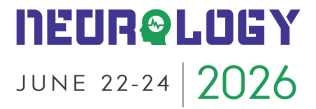Title : Transcranial Direct Current Stimulation (tDCS) for chronic migraine: A randomized clinical trial with 20 patients
Abstract:
Background: Chronic migraine is a disabling and often treatment-resistant neurological disorder. Transcranial Direct Current Stimulation (tDCS) is a non-invasive neuromodulation technique with emerging evidence for pain management. To assess the efficacy and safety of anodal tDCS applied over the primary motor cortex (M1) in reducing pain intensity and migraine frequency in patients with chronic migraine, compared to sham stimulation. Twenty adults (12 women and 8 men; age range 27– 46) diagnosed with chronic migraine (ICHD-3) were randomized into two groups: Active tDCS (n=10) and sham (n=10). The active group received 2 mA of anodal tDCS over M1 (C3) for 20 minutes/day, 5 days/week for 4 weeks. The sham group received stimulation for only 30 seconds. Pain intensity (Visual Analog Scale) and monthly migraine frequency were assessed at baseline, post-treatment, and 5 weeks follow-up. The active tDCS group showed a mean pain intensity and migrane frequency reduction. No adverse events were reported. Anodal tDCS over M1 significantly reduced pain intensity and migraine frequency in chronic migraine patients, with effects sustained for five weeks post-treatment. tDCS was safe, well-tolerated, and may represent a valuable non-pharmacological intervention.
Keywords: Chronic Migraine, tDCS, Neuromodulation, Pain Management, Non-Invasive Stimulation, Clinical Trial.
Introduction: Chronic migraine is a highly disabling neurological condition characterized by the presence of headache on at least 15 days per month for more than three months, with at least eight days having features of migraine without aura. It represents the most severe end of the migraine spectrum and affects approximately 1–2% of the global population, disproportionately impacting women. The pathophysiology of chronic migrane is multifactorial, involving both peripheral and central mechanisms. A pivotal role is played by dysfunction in the trigeminovascular system, which leads to the release of Calcitonin Gene-Related Peptide (CGRP), a potent vasodilator and pro-inflammatory neuropeptide. This cascade promotes neurogenic inflammation, peripheral sensitization, and activation of second-order neurons in the trigeminocervical complex. Over time, repeated migraine attacks can induce maladaptive neuroplastic changes, including central sensitization and decreased efficacy of descending pain modulatory systems, especially involving the periaqueductal gray and thalamus. Structural and functional neuroimaging studies have consistently demonstrated alterations in key brain regions in patients with chronic migrane, including increased iron accumulation in pain-modulating structures and abnormal functional connectivity in the default mode and salience networks. These findings support the hypothesis that chronic migrane is not merely an extension of episodic migraine but a distinct disorder with unique central nervous system alterations. Chronic migrane frequently coexists with psychiatric comorbidities such as depression, anxiety, and sleep disturbances, as well as metabolic conditions like obesity and insulin resistance. These comorbidities not only complicate diagnosis and management but also contribute to disease chronification. Moreover, medication overuse headache arising from the excessive use of analgesics, triptans, or combination drugs is present in nearly half of patients with chronic migrane and further reinforces the vicious cycle of pain and medication dependency.
It presents significant disability and burden and is often refractory to both acute and preventive pharmacological strategies. Neuromodulation techniques, including tDCS, are promising alternatives or adjuncts to pharmacotherapy, particularly for patients with medication overuse, intolerance, or inadequate response.
Methods: This was a double-blind, randomized, sham-controlled trial involving 20 adults, age range 27– 46 (12 women, 8 men) with chronic migraine based on ICHD-3 criteria. All patients signed the informed consente form. Participants were randomly assigned to receive either active or sham tDCS. There were 10 people in each group (active and sham), matched by age. The active protocol involved anodal stimulation at 2 mA over the left primary motor cortex (C3 when we use the 10-20 system of the electroencephalogram) or M1, for 20 minutes daily, five days a week, for four weeks. The sham protocol mimicked the procedure but with current discontinued after 30 seconds. Primary outcomes included changes in pain intensity, assessed by the Visual Analog Scale (VAS), and monthly migraine frequency. Assessments were conducted at baseline, immediately post-intervention (four weeks) and after 5-week of the last stimulation.
Results: At week 4, the active group exhibited a mean VAS pain reduction of 76.6% (SD=5.8) compared to 8.5% (SD=9.1) in the sham group (p<0.001). The migraine attack frequency dropped by 49.8% (SD=8.1) in the active group, compared to 11.0% (SD=14.9) in the sham group (p<0.001). These benefits persisted at the 5-week follow-up. No adverse effects were reported in either group.
Discussion: The present findings demonstrate that anodal Transcranial Direct Current Stimulation (tDCS) applied to the primary motor cortex (M1) significantly reduces both pain intensity and monthly migraine frequency in patients with chronic migraine. The reduction in mean Visual Analog Scale (VAS) scores by 76.6% and attack frequency by nearly 50% is not only statistically significant but clinically meaningful, especially considering the typically refractory nature of chronic headache.
These results are consistent with prior studies exploring neuromodulation in migraine. While earlier work by Antal et al. (2011) applied cathodal tDCS over M1 and observed reductions in migraine days and pain intensity, our study suggests that anodal stimulation which increases cortical excitability, may be equally or even more efficacious, particularly when applied with a higher intensity (2 mA) and longer duration (20 minutes per session). This polarity-dependent variability underscores the complexity of tDCS mechanisms and supports the growing view that individualized montage selection may be necessary for optimal outcomes. The robust and sustained effects observed at the five week follow-up suggest enduring neuroplastic changes in cortical and subcortical pain networks. M1 stimulation is hypothesized to modulate the activity of thalamocortical pathways and the descending pain modulatory system, particularly through enhanced connectivity with the periaqueductal gray, anterior cingulate cortex, and dorsolateral prefrontal cortex. These mechanisms may underpin both the antinociceptive and frequency-modulating effects observed.
Importantly, the intervention was well tolerated, with no adverse events reported, consistent with the established safety profile of tDCS in neurological populations. This aspect is crucial, particularly for patients with contraindications to pharmacotherapy, history of medication overuse headache, or intolerance to preventive agents such as topiramate or β-blockers. In this regard, tDCS offers a non-pharmacological, low-cost, and portable option for chronic migraine management, which may be integrated into broader multidisciplinary care programs. Our findings also have implications for the biopsychosocial model of migraine, especially considering that many patients suffer from comorbid anxiety, depression, and sleep disturbances. tDCS may potentially influence these domains by modulating large-scale brain networks implicated in mood and arousal regulation, though this hypothesis warrants targeted investigation.
Despite the promising outcomes, several limitations should be acknowledged. The sample size, while sufficient for preliminary efficacy analysis, was small and may limit generalizability. Additionally, the absence of neurophysiological or imaging biomarkers precludes definitive conclusions about the mechanistic underpinnings of the observed changes. Future trials should consider incorporating measures such as EEG, fMRI, or quantitative sensory testing to explore how tDCS modifies pain-related brain activity and connectivity. Another area for future research involves optimizing stimulation parameters, such as electrode placement (e.g., bilateral M1 vs. M1–DLPFC montages), session frequency, and duration of treatment to achieve durable remission. Moreover, combination therapies involving tDCS and behavioral interventions like cognitive behavioral therapy or mindfulness-based stress reduction may synergistically target both neurophysiological and psychological contributors to chronic migraine.
Conclusion: This study adds to the growing body of evidence supporting the use of tDCS as an effective, safe, and non-invasive treatment for chronic migraine. Anodal stimulation of the primary motor cortex resulted in significant reductions in pain intensity and migraine frequency, with benefits sustained at follow-up. These findings suggest that tDCS may facilitate neuroplastic remodeling of pain-related neural circuits and serve as a valuable adjunct or alternative to pharmacologic treatments. Larger, mechanistically informed trials are warranted to validate these outcomes and optimize stimulation protocols for broader clinical application.




